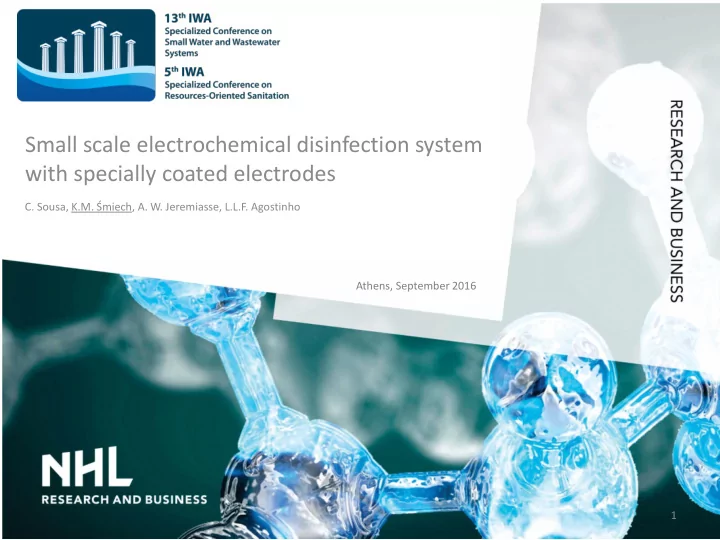

Small scale electrochemical disinfection system with specially coated electrodes C. Sousa, K.M. Śmiech , A. W. Jeremiasse , L.L.F. Agostinho Athens, September 2016 1
Outlook • Background: (Electrochemical) water disinfection • Methods • Experimental setup • Results: Disinfection efficiency Produced disinfectants Disinfection byproducts and heavy metals • Summing up 2
Water disinfection Important for preventing the spreading of waterborne diseases Methods 1 : • Chemical e.g. Cl 2 , ClO, O 3 • Physical e.g. UV • Physical-chemical e.g. electrochemical Electrochemical disinfection efficiency: • Electrolyte • Current (density) • Electrode material • BDD • MMO 1 Martinez-Huitle, C., & Brillas, E. (2008) Electrochemical alternatives for drinking water disinfection. Angewandte Chemie International Edition 47 (11), 2-10 3
Methods • 2 electrochemical cells • 2 MMO types (Ru, Ir, Ti) ON2012 ON2038 Total flowrate = 4 m 3 h -1 • Cl - concentration = 49 mg L -1 • • Disinfection efficiency for 3 bacteria and 1 virus E.coli S. epidermidis R. terrigena bacteriophage MS2 • Analysis for THM • Analysis for heavy metals 4
Experimental setup 5
Disinfection efficiency Bacteria*: > log 6 disinfection Virus**: log 3 – log 5 disinfection 20 14 18 12 16 6,36 6,43 6,22 14 10 Log (CFU/mL) Log(PFU/mL) 6,31 12 5,69 5,62 8 10 6,19 6,39 6,01 6 8 6 4 4 5,78 5,78 5,72 2,69 6,19 6,22 6,16 2 2,27 2 2,54 1,16 0,78 0 0 0 0 0 0 0 0 0 0 0 0,00 IN OUT IN OUT IN OUT IN OUT IN OUT IN OUT 0 min 30 min 60 min 0 min 30 min 60 min 30 min. E. coli S. epidermidis R. terrigena MS2 cell 2038 MS2 cell 2012 * Method: Heterotrophic plate count. Standard Methods for the Examination of Water and Wastewater (APHA). ** Method: ISO 10705-1:1995 Detection and enumeration of bacteriophages . Part 1: enumeration of F-specific RNA bacteriophages. 6
Produced disinfectants IN OUT 2012 OUT 2038 range Free Cl (mg L -1 )* 0 0,37 1,38 0,5 – 3 O 3 (mg L -1 )** 0 0,33 0,36 0,1 – 0,8 Active chlorine production: > 90% Coulombic efficiency *Method: ISO 7393/1:1998 Water quality -- Determination of free chlorine and total chlorine -- Part 1: Titrimetric method using N,N-diethyl- 1,4-phenylenediamine. **Method: H. Bader & J. Hoigné (1981) Determination of ozone in water by the indigo method. Water Research 15(4), 449-456 7
Disinfection byproducts and heavy metals • Total THM ~0,6 μ g L -1 as AOX • << 60 μ g L -1 WHO guideline • Including BDCM ~0,16 μ g L -1 Heavy metals (Ti, Ir, Ru) < 10 μ g L -1 (max. advisable level for drinking water) • safe water produced 8
Summing up Small scale (2 x 2 m 3 h -1 ) electrochemical disinfection system with specially • coated electrodes (MMO with Ru and Ir) Treatment of waters with low Cl - content (49 mg L -1 ) without salt addition • • Disinfection efficiency: • bacteria: > log 6 • virus: log3 – log 5 • Produced disinfectants included: • Free Cl: 0,5 – 3 mg L -1 • O 3 : 0,1 – 0,8 mg L -1 • THM: ~0,6 μ g L -1 as AOX, i.e. << 60 μ g L -1 WHO guideline • Heavy metals (Ir, Ru, Ti) < 10 μ g L -1 9
Acknowledgements 10
Thank you very much! Questions? karolina.smiech@hvhl.nl 11
Recommend
More recommend